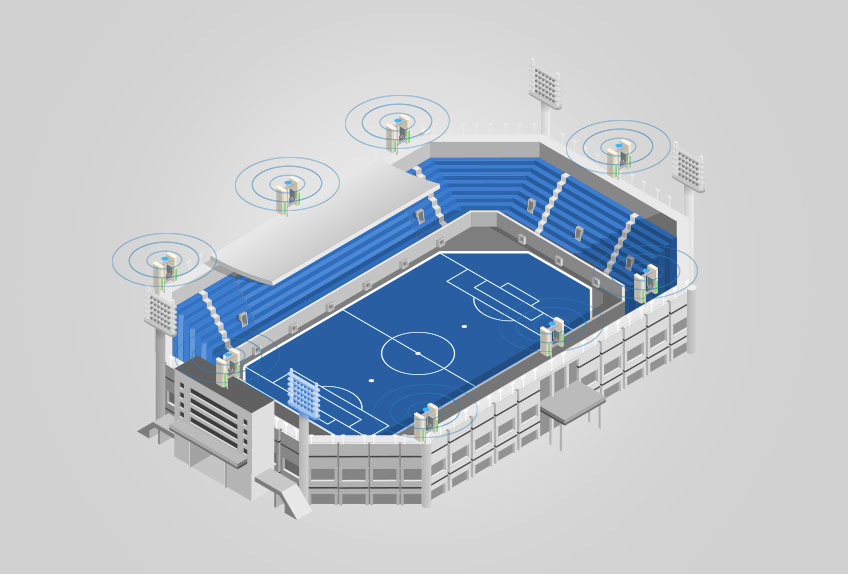Both statistical data and the couch-comfort check tell us that watching sports and events on TV is as good, if not a better viewing experience. People today own comfortable digital nests, and getting them out is extremely hard. Stadium attendance rates are stagnated, the event’s usually never sell out, and there are traffic pile-ups in the parking lots. Compare this to zoomed-in slow-motion captured live streams with endless factoids about the sports game on your mobile, and it’s safe to say live events are under threat.
There is an urgent need to reimagine the in-stadium experience for the digital fan, and the NFL is doing it right. After investing in stadiums with wireless connectivity, the modern NFL fan has a digital journey as well as a physical one when they arrive at stadiums. Starting with parking management, personalized engagement, and ticketing, fans can even order refreshments or sports paraphernalia, partake in digital celebrations and find their way back to their car with ease.
Unlocking the True Potential of Sports & Events with DAS
At the base of this experience is a DAS infrastructure. Distributed Antenna Systems are an ideal wireless solution for stadiums and arenas. These solutions are scalable, turn-key, and proven to work. They work for all mobile carriers and allow you to provide the experience worth leaving the digital nest.
A Deloitte insights report on ‘Redesigning stadiums for a better fan experience’ describes how the modern fan in-stadium journey should be. At its core, it’s all about fan engagement at a personal and community level. Stadiums and arenas also need to provide unique content opportunities that fans simply cannot get at home. It’s all about the coolest fan experience ever.
The pandemic has also furthered the development of better at-home fan experiences and although people are excited to get out stadiums and arenas still have the odds stacked against them. Stadium owners and other stakeholders need to rethink the stadium experience. This is where ‘smart stadiums’ come in.
Smart stadiums use wireless connectivity along with a network of sensors, cameras, digital signs, and screens to create a truly connected platform. According to Intel, there are several ways smart stadiums relieve the pressures on stadium operators to make a profit. Although the entire system may be expensive, upgrading the fan experience while creating better profit margins is worth it in the long run.
DAS Helps Create Scalable Stadium Solutions
Arenas and Stadiums are particularly harsh environments for wireless voice and data communications. Trends suggest that we are only going to have more devices incorporated into our lives, and making a decision about upgrading stadium connectivity requires significant consideration towards the future.
This was the policy adopted by the Golden 1 Center, home of NBA’s Sacramento Kings. DAS was adopted to provide wireless coverage to more than one million square feet. The indoor-outdoor DAS also provides coverage in the plaza and is ready to support 5G bandwidths.
Levi’s Stadium took it a step further and installed a DAS system that boosts capacity beyond its stadium so surrounding neighborhoods could also benefit from stadium DAS. The scale and extent with which you can deploy stadium DAS solutions is not a choice, but rather a long-term connectivity solution that provides endless benefits to a whole bunch of users and fans.
With scale totally at the control of the stadium owner, DAS can be used to create experiences that are truly worth getting out for. Fans today need a connected experience and stadium brands do too. With DAS capable of enabling other service providers such as in-stadium VR, fan relationship management, food history, etc stadium owners can come out with ways to not only boost sales for one-time events but create sales over an extended period of time.
Yes, DAS solutions enable more sales at arenas and stadiums!
Capacity Planning for DAS
Live events can involve tens of thousands of fans. Averaging at 2 devices per person, the number of audience devices can be expected from 10,000-100,000. Add to this the number of sensors and devices that audience services need and the number easily doubles to 20,000-200,000. All surveys and reports indicate the number of devices is only going to increase. This is where the scalability and capacity planning DAS provides are unparalleled.
Stadiums have large architectural infrastructures and unique traffic flow patterns. To bring reliable connectivity, several antennas and access points are used. The location and planning of these require network planning experts and the creation of network maps. This also gives stadium owners complete flexibility over the hotspots and allows experience planners to utilize the entire stadium to provide a unique fan experience.
With the rise in IoT solutions, stadium owners can capitalize on smart technology to drive new revenues while decreasing expenses and increasing existing revenues. The guiding principle behind this though is one of thinking big, starting small, and scaling fast. By investing resources in IoT strategy, sports, and events can rely on technology to scale and grow their investment.
Digital Stadium – Home of the Digital Teams
A digital stadium is also necessary for a data-led team. Several NFL and NBA teams already use data analysis to recruit and develop players. Additionally, stadium owners have reported increased efficiency in operations, engaged fans, and access to new revenue streams. Introducing strong fan experiences and personalized real-time information is going to help create loyalty for the team that calls the stadium home.
The earnings and stakeholders in creating a DAS system are many, as are the rewards. And stadium owners who don’t move in first will have trouble keeping up with the field in the years to come.



Post a comment